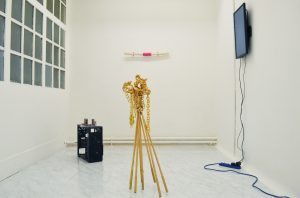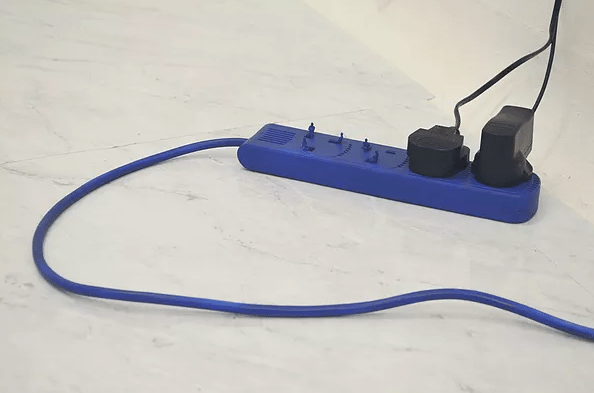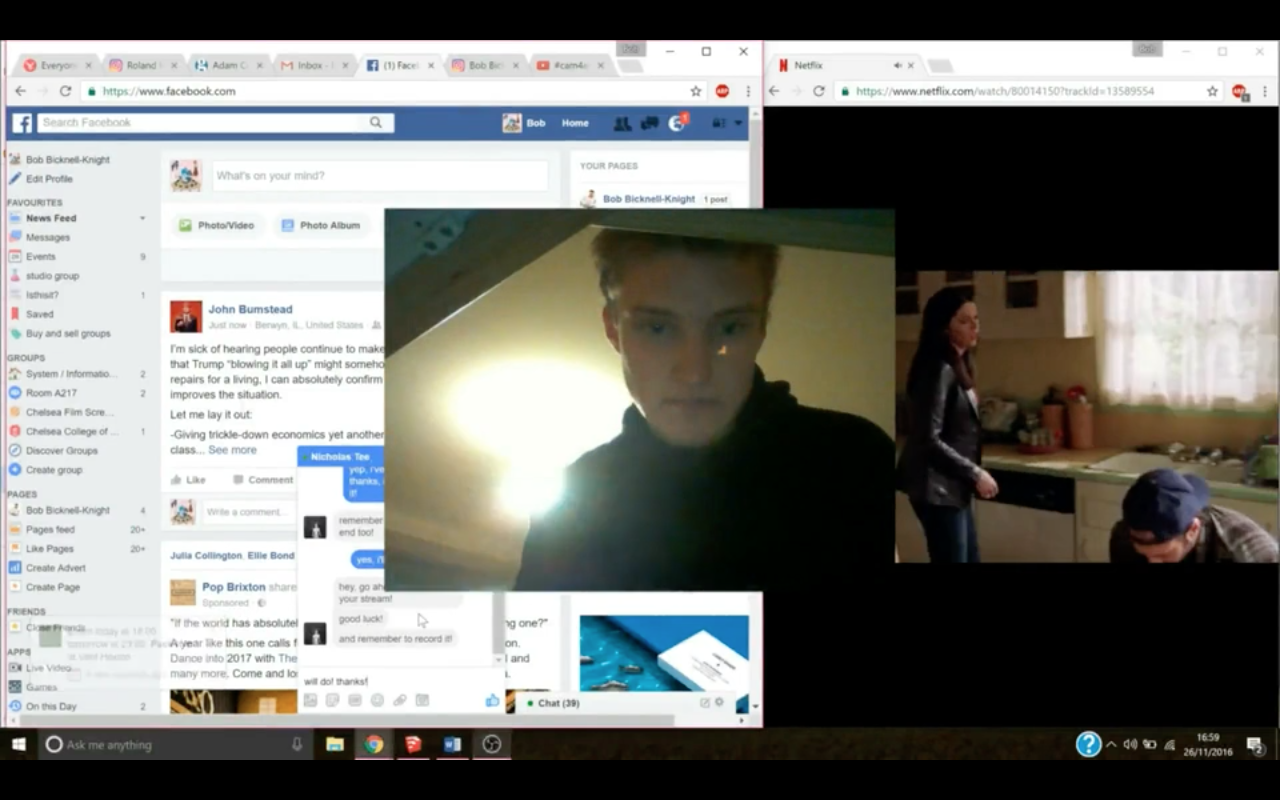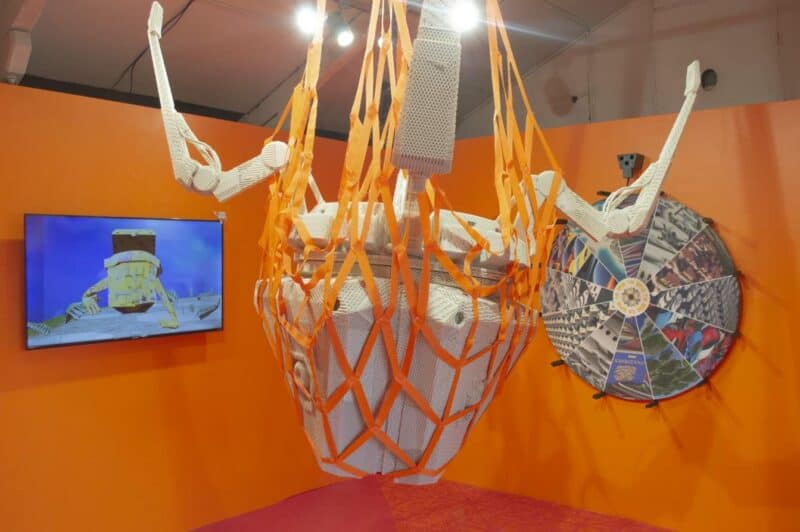FAD sat down with Bob Bicknell-Knight to discuss his practice and recent projects. Bicknell-Knight is a London-based artist whose work examines the internet and consumer capitalist culture. He is the director of A217 Gallery and founder of isthisit?, a platform for contemporary art that contains online exhibitions, a residency and a magazine. Bicknell-Knight currently has a series of videos being showcased on the video channel DVD IS DEAD, has an upcoming online residency with IOUAE and an exhibition at Serf Studios in April, and is curating a pavilion for the Wrong New Digital Art Biennale in November.

I miss you, Blockbuster, 2017. Installation shot of A217 Gallery.
First of all, I wanted to discuss the multifaceted nature of your practice. You have a lot of different projects that you’re working on simultaneously – you make work, you are the director of a gallery and the founder of a magazine. I was wondering how each of these feeds into the other for you?
For me, it’s quite a fluid ‘feeding’ process, with the majority of work that I curate, and the types of shows that I organise, being inspired by my own artistic interests and influences. A lot of my work considers the aesthetics of the internet, how it’s evolved since the 90s and how it’s inherently changed us as human beings. This premise was the starting point for the first issue of the magazine and the main idea behind a recent group exhibition at A217. I feel like there’s a reciprocal arrangement, with my curatorial side effecting my own artwork, often reflecting on and observing my work as a curator as well as making work from a curator’s point of view. To separate these aspects of my practice into individual boxes would be taking a step back, similar to an artist neglecting to make work about a major part of their life, eventually that becomes unsustainable and the flood gates are opened.
I was wondering what your thoughts are on the artist-cum-writer-cum-curator that is a fairly common role nowadays (and one that you fall under)?
I love working within these different roles, even if it’s fairly hard sometimes to transition from writing emails and undertaking general admin to thinking about my own artwork generation. As a curator a lot of what I do is focused on building relationships with artists, an incredibly fulfilling experience and one that also feeds into my own art practice. Finding people whose work you admire and having meaningful conversations with them is furthering both my curatorial career as well as my artistic one. Although, I have to be conscious of falling into the trap of simply curating the friends that I’ve made, especially when I’m having a dialogue as a fellow artist and a curator simultaneously.

Bob Bicknell-Knight, Extended Self, 2016. Courtesy of the artist.
Considering your role as a curator, in your recently curated show I miss you, Blockbuster at A217 gallery, it is noticeable that your own work in the show facilitates the power for another artist’s video work. Can you talk a bit about this and its significance?
With the majority of my curatorial projects I do like to include a work of my own, usually these are intentionally small pieces that can be easily missed. In the recent show at A217, I created the site-specific work Extended Self which was an extension lead spray painted blue with tiny plastic blue figurines dangling their feet into the socket holes. This is an example of my general art practice supporting the work of others. Although I’m aware of curators losing some sort of integrity when they include their own artwork in the shows they curate, at the moment a lot of my work fits in with the artwork that I’m interested in showcasing. In a past physical exhibition, my work manifested itself as a digital print of a screengrab of a fictitious desktop, screen printed onto a curtain blocking onlookers from seeing the show from the street. A lot of the time in my work, blue is used as a symbol of capitalism, an aspect of western society that I certainly can’t see any of us being able to live without, like electricity and the internet. In this case, capitalism is feeding and facilitating a video piece by Karl Sims called Desert Island Desktop where Sims made the entire video whilst disconnected from the internet, which was specifically made for the Instagram video channel DVD IS DEAD. I enjoyed the irony of this idea and wanted to work with the parallels between the inescapable aspect of the internet and our consumer capitalist culture.
Your most recent video work uses found footage from an abandoned scene in Friends which had to be taken out due to its discussion of a bomb and close airing time to 9/11. Forms of security and control often feature in your work. Here, especially it is seen in terms of airport security. Why is this a fascination in your practice?
Security, and in turn surveillance, has interested me for a while now, ever since the Snowden revelations in 2013 made it clear that we’re living within the dystopian fantasy of a science fiction novel. The control that the government and corporations have over users of the internet is deeply disconcerting to me, whilst simultaneously making me wonder what’s going to happen next, or what’s happening right now that the general public aren’t aware of. The video begins by reflecting on how relaxed airport security was in the pre-9/11 world, utilising the footage from Friends to do so, then proceeding to look into the present and the future of airport security and how technology is transforming the way we navigate through daily western life, Amazon drones, programmable electronic bees, etc. It also considers various case studies where airport security has been superseded by terrorists and the repercussions of those actions, for the terrorists and society in general.

isthisit? magazine, Issue 1.
Congratulations on the upcoming publication of isthisit? Can you tell us about the first issue and the concept behind it?
With isthisit? I’ve been experimenting with the various avenues that curators can create and be involved with, so I guess putting out a publication was the logical next step. It began by opening up a call for any and all types of art, which, as I mentioned before, was eventually curated and confined to work taking inspiration from the internet, and seeing technology as a tool that’s changed how the majority of the western world functions in society. Within the publication this is explored through essays that have either been written specifically for the magazine, or ones previously written being shown here in a new context, as well as a series of artist interviews where I begin each one by asking the artist how their work relates to the internet, with the following conversation turning into more of a discussion than an interview. The main body of the mag consists of various artist works, from paintings and digitally rendered images to screengrabs of videos and photographs of sculptural works.
Considering isthisit?’s content, it obviously works well as an online platform. What are the similarities or differences between what the platform does online vs. offline?
Although there are many beautiful things that the internet has allowed the art world to achieve – allowing art to be seen anywhere and everywhere with an internet connection alongside creating a wider audience to see work – I feel like online exhibitions aren’t deemed as important as offline events, which is why I decided to branch out to physical exhibitions in the first place… The online part of isthisit? functions as weekly exhibitions that are curated by myself and a series of guest curators that I invite to take part in the platform, as well as a monthly residency and ‘curatorial notes’ that are written by the curators and published after the initial online exhibition goes live. Offline involves occasional exhibitions and now the magazine. As I talked about earlier, the ideas that I’m involved and interested in hopefully manage to fluidly move through both the online and offline spheres of isthisit?.
We were talking about the layout of the upcoming magazine and its ironic approach as a physical object that focuses on digital life. For example, the interviews are laid out as if conducted via iMessage. Can you talk a bit about this and the significance of printed material today in a heavily digital world?
In the most literal way I wanted to examine the various ways that we induce data on the internet, so all the interviews are laid out on iMessage, the essays as if they’re emails and all of the actual artwork is embedded within different computer windows, from Tor Browser to Photoshop. I was interested in the aesthetics of these different computer programs and I feel that utilising them in print form makes the reader aware of the subtleties in the designs of these programs due to the physicality of the screens, rather than simply encountering them as a PDF embedded within yet another window of their computer screen. Through these subtle references it was also a way of staying connected to the internet when it was eventually printed, communicating that the content was all internet or technologically themed without having to read a single word.

Watching Me, Watching You, 2016. Courtesy of the artist.
Online performance features regularly on isthisit? and has also been used in your own practice, for example the piece Watching Me, Watching You where you appear on webcam. The recurrence of artists using themselves online immediately speaks of present day individualism. Is this something that you are thinking about?
With Watching Me, Watching You the piece is very much about the lack of individualism on the internet, with everything that you see me do over the 2 hour period being incredibly similar to what someone is probably doing whilst watching the piece; browsing through Facebook whilst simultaneously watching a tv show on Netflix and eating their dinner. A lot of this comes back to an essay by Clifford Stoll from ’95 published in NewsWeek that talks about how the internet will be filled with a cacophony of voices where no one can be truly heard. Stoll was mocked at the time but I feel that in the current climate his writing is very true to what the internet has become. Although in retrospect the piece does deconstruct and seeks to show how I personally browse the internet, so in that sense it is about how I privately function in a virtual space.
Is online performance a way to take back and engage in a certain immediacy that is often lost as we seek to carefully edit and control the online sphere?
Definitely, as we’ve grown accustomed and emotionally tethered to our devices the screen has become its own familiar object that we have a complicated relationship with, so I always tend to feel incredibly engrossed by live performances being streamed over the web, be that because of their ‘live’ aspect or the voyeuristic notion of being able to see them and them never being able to see me through this one-way window.
You are the director of A217 gallery. Can you talk a bit about the gallery and its programme?
As a gallery we try to host monthly exhibitions, with each exhibition being curated by one of our directors. As we all have different interests and artists that we’ve fostered relationships with, each month one of the team becomes the lead curator, deciding on a theme and meeting with the group to discuss the ideas behind the show alongside which artists they want to get in contact with. For the moment, monthly exhibitions are what we’re working towards, although the possibility of holding events at the gallery is something that we’re currently discussing.
What upcoming exhibitions do you have at the gallery?
So, at the end of April we’re going to be putting on a show curated by Emily Thomas focusing on the architecture of domestic spaces, and then in May Ambar Quijano will be curating another group exhibition. Both of these exhibitions are still in the process of being organised. After that we’ll be putting on our first solo show which is currently being planned.
https://www.bobbicknell-knight.com/
To purchase the first issue of isthisit? magazine, follow this link.





